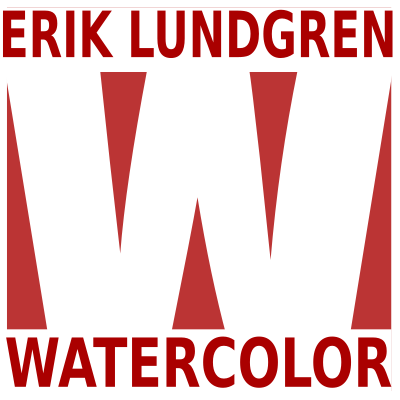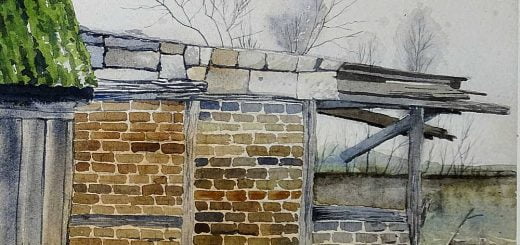Wet on wet

Wet on wet means painting with watercolor paint on an already wet paper. The wet surface of the paper can be clean water or wet paint. The result is that the paint from the brush spreads over the wet surface. How much and in what way depends on the paper, how wet it is, the pigment, the brush, how much paint is used, the technique, etc. Thousands of variables.
The best way to understand how wet on wet works is to paint wet on wet. To try for yourself. There are so many factors that affect the outcome to describe them all would be very comprehensive. I will divide the description into different parts: paper, brush, paint, to make the technique clear, but if you are going to learn, you have to practice (as with everything).
The paper
As always, I advocate a cotton paper with sizing (read more here), they are a little more expensive but without one it is difficult to paint watercolor. In terms of sizing, I think Arches and Langton Prestige have similar characteristics. Canson Heritage has a very durable surface that works very well wet on wet, Saunders Waterford feels a little softer but if you want a really soft paper that gives fantastic wet on wet transitions, you should try Millfordwhich has no glue on the surface but is very softly glued to the pulp, it is absorbent and soft. For all cheaper papers, you can just say that they are all different, some are decent to paint wet on wet on, while most are useless for the purpose. The price decides, more expensive is better!
Wet paper
How wet the paper is determines how much the paint will run out. A very wet paper causes the color to flow out a lot, while a drier paper only causes a small outflow of color. If the paper is so wet that the water is on top of the surface and floating, it is probably too wet to paint on, if on the other hand the paper has become so dry that it is no longer even a little shiny on the surface, it is probably too dry. Of course, there are many steps between very wet and just slightly damp. It is important to find the right moisture for the exact effect you want. There is only one way to learn this: practice. You must have experience to understand how the color behaves on a wet paper.
When you are going to wet your paper, you should use a lot of water, then let the water be absorbed by the paper until it is moderately moist on the surface, it is better to use a lot of water and let the paper absorb it than just wet a little on the surface.
The brushes
If you use a brush that holds a lot of liquid, for example one of squirrel hair, the brush also gives off a lot of liquid. It can easily become too much paint. Preferably use a simpler, smaller brush to add paint to a wet paper. It is an advantage if you do not add as much paint. You can say that the brush should be drier than the paper. If you add a lot of liquid with the brush, the color will probably flow uncontrollably on the paper, with a wet paper and just a little color in the brush, you control the result much better.
Summary: with a simple synthetic brush, preferably in a smaller size, it is easier to paint wet on wet than with a large “nice” brush that adds too much new liquid to the paper.
Different colors
Some pigments flow out a lot on a wet paper, others just lie down and die. How a pigment behaves depends on how small the pigment grains are and how heavy they are. A light pigment such as cadmium red (or yellow) floats with the water and gives nice transitions, while a heavy pigment such as French ultramarine reluctantly moves. Slightly simplified, it can be said that granulating paints do not flow out, while paints that do not granulate are easily mobile in water.


You can easily try how much your favorite colors move in water, wet a piece of paper, wait until it is “just right”. Then put a drop of paint of all the colors you want to test on the paper, try to use the same amount of water and degree of dilution for all the colors. Some colors will flow out a lot, they are easy to paint wet on wet with, while others will only give a small area with paint, they are probably harder to use for wet on wet.
The technique
The material is important for how the result is wet on wet. But the way the color is placed on the paper also plays a big role for the result. A quick brush stroke does not give as much color to the wet surface as a slow brush, it will be different if you only paint with the tip of the brush or if you press and use the entire brush bristles. If you lift the brush in the middle of a brush stroke, it leaves a circular stain, it will be different if you dab with the tip or paint long brush strokes.
Summary
There are so many variables that it is impossible to describe them all: the type of paper matters, the amount of water on the paper, how much color you have in the brush, the size of the brush, the technique with which the paint is applied to a wet paper and what colors are used . Everything is important, practice a lot and you will gradually gain experience. Even an experienced watercolor painter is surprised when the paint behaves as in an unexpected way. It happens in almost all paintings, That’s the Way It Is, watercolor has a will of its own















